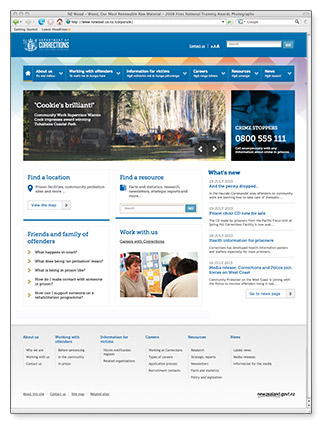
Department of Corrections
Size: big!
Government status: Government Department
My professional status: contractor at the Department of Corrections
Website client: Department of Corrections
Dates: April - May 2013
Categories: Client liaison, Govt web standards tester, Writing for the web, Content-loader, Squiz/MySource Matrix, Government websites, Large sites
Brief: to act as content-loader and web editor during the development of the new Corrections website (a restructure, redesign, and rebuild of an existing website). The new website had been designed by Provoke, and was being built in Squiz Matrix by Optimation.
Initially I was taken on by Corrections as a web content co-ordinator, with my main responsibility being to help their web team to transfer content from their old website to the new one, and to ensure that it was formatted correctly once it got there.
I ended up working alongside Steve Beckett, the Corrections project manager, trying to ensure that the development and integration of the site matched the original design and that it would be easy to use for the ongoing web editors at Corrections.
Achievements:
- Provided expert web-focused advice to Steve relating to the design and development of his new site, and what he as a client could expect in terms of consistency between the original design and the final build
- Acted as a subject-matter expert in meetings with the design and development companies, working to ensure that Corrections were getting value for money and a high-quality product
- Suggested improvements to the build that would help the Corrections web editors to do their job
- Provided an ongoing and constantly updated overview of the content migration process via the use of a comprehensive Excel spreadsheet, enabling the members of the web content team to track and record their work on this very large website.
My responsibilities included:
- Creating an Excel spreadsheet which listed all the pages on the new website and where they would appear within the sitemap, together with information about editing status, associated images, who was responsible for content-loading and editing, and at what stage in the migration process each page was at
- Transferring content from the old site to the new, and formatting it once it had been transferred
- Attending team meetings with the Optimation developer and testers to ensure that the project was on-track, and that the front-end development and integration was of a sufficiently high standard
- Attending team meetings with the Provoke designer and design director, to get an overview of how the site should look and to discuss whether the development accurately reflected this
- Reviewing the pages that had already been migrated to the new site, and doing QA on these
- Discussing the information architecture and website structure with the Corrections Comms team
- Ongoing PixelPerfect testing of the website pages as the site was being built and integrated into Squiz Matrix, aiming to ensure that the finished website would display exactly as Provoke had designed it
- Ongoing bug-testing of the website pages as the site was being built and integrated into Squiz Matrix and recording these bugs; together with online bug-fixing using Firebug which I then forwarded to the developer at Optimation
- Ongoing feedback to the Optimation developer as we began using the Squiz interface to edit the resources - making suggestions for usability improvements to the editing environment, and making requests for various elements to be added to this interface to make life easier for the website's future web editors
- Being an e-govt compliance and accessibility advocate at all stages of the process.
Steve and I have worked together in the past (on the MyVictoria project) and he knew that my skillset is broader than web editing alone, so we ended up working together on this project. I acted as a bit of a sounding-board for Steve, as well as a consultant on all things web - including what we should expect from the integration process, and how closely I felt it should match the original design in terms of pixel-perfection.

